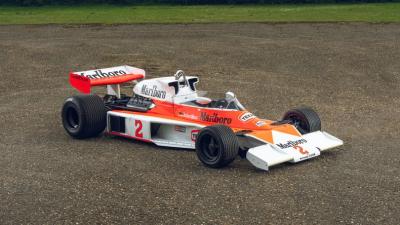McLaren started the 1973 Formula One season with drivers Denny Hulme and Peter Revson piloting the soon to be obsolete M19 while they waited for the highly anticipated and developed M23. By the third round of the year Hulme was equipped with the first chassis and for the following round both drivers had what was to be McLarenâs best Grand Prix car to date at their disposal. Little did they or indeed anyone know how successful the M23 would be but in that first year Hulme won in Sweden while Revson took his maiden victory at the British Grand Prix and what was to be his final victory at the Canadian Grand Prix. The 1974 season saw the change from a Yardley livery to Marlboro and the M23 took a further four wins with Hulme and Emerson Fittipaldi, with the latter claiming the World Championship and McLaren their first Constructorsâ title. McLaren continued upgrading the car as they learned more, and applied developments based on the sporting regulations. Despite entering their third season with the M23, 1975 saw further wins for Fittipaldi with Jochen Mass scoring his sole Grand Prix victory at the Spanish Grand Prix. For 1976, a lower airbox configuration and gutsy driving brought James Hunt the World Championship in what was one of the most memorable seasons of all time. Despite now being at the end of its fourth year of Grand Prix racing the M23 was clearly still the car to beat at the front of Formula One. This car, M23-12, is the penultimate car of the 13 built and the last M23 built for âworksâ use. It was introduced for Jochen Mass to use at the 1977 US Grand Prix West held at Long Beach in California. A disappointing qualifying and retirement at just before half distance was a disappointing debut for the chassis but the following round at Jarama in Spain was far more fruitful for the German. Starting 9th he battled his way up to fight the Wolf WR1 of Jody Scheckter for the final spot on the podium, narrowly missing out with the pair finishing less than three tenths apart as they crossed the line. Denis Jenkinson described the battle as âvaliantâ in the Motorsport Magazine race report. Monaco saw another points finish with a 4th place for Mass and at the following race in Belgium M23-12 briefly lead before retiring with an engine failure. The 1977 Swedish Grand Prix represented the best result for M23-12 with Mass coming within eight seconds of winning the Grand Prix and taking a fine podium with a 2nd place finish. With the introduction of the M26, the final race for chassis number 12 was at the French Grand Prix where Mass finished in 9th place. The car was taken to the British, German, and Austrian Grands Prix where it was used in practice, but the team reverted to the newer M26 for qualifying and the races themselves. Following its active career in Grand Prix racing the car was sold in late 1978 by McLaren directly to Harley Cluxton III in Arizona, United States. Cluxton, a well-known figure in the U.S. racing world, having been a N.A.R.T. Ferrari driver and successful sports car entrant throughout the Seventies, retained the car until selling it to Steve Earle in 1986. Earle, who founded the world-famous Monterey Historics event at Laguna Seca, regularly competed with the car over the two decades in which he owned it. The last U.S. based owner to date was Richard Griot who also campaigned the car with success from 2007 until it finally made its return to Europe when he sold it in 2015. In its current ownership M23-12 has enjoyed a âno expense sparedâ approach to preparation and has been campaigned competitively across Europe in the FIA Masters Historic Formula One Championship. With Austrian Lukas Halusa behind the wheel chassis number 12 captured the 2021 Masters Historic Championship. Preparation by Hall & Hall and skilled driving by Halusa saw weekend sweeps at Donington Park, Brands Hatch, and Silverstone with an additional round 10 victory at Spa that October. The car was also invited to the McLaren 60th Anniversary celebrations at the Goodwood Festival of Speed where it represented the marque in their dedicated class. Most recently the car was raced at the Grand Prix Historique de Monaco 2024, where it achieved a fantastic 4th place finish. As a 1976 specification M23, it runs as the youngest car in Serie E making it an attractive proposition for anyone looking to race at the front of the grid in the worldâs most prestigious historic Formula One event. Looked after by respected experts Hall & Hall in the UK, the car has a Geoff Richardson Ford-DFV engine which has just been refreshed to the tune of over £30,000, leaving any prospective buyer with a turn-key Grand Prix car to enjoy the balance of the 2024 race season and beyond. It is also offered with a handsome package of spares to include wheels, bodywork, wishbones, shock absorbers, and a host of running spares. Additionally, it is supplied with a report from 3.0-liter Grand Prix car authority Allen Brown illustrating M23-12's fantastic period history and known ownership history from new. With a proven contemporary track record, M23 chassis number 12 is an uncommon opportunity to acquire a rare and significant McLaren Formula One car. Ownership History⯠1976-1978 Bruce McLaren Motor Racing Ltd ⯠1978-1986 Harley Cluxton, USA⯠1986-2007 Steve Earle, USA⯠2007-2015 Richard Griot, USA⯠2015-2020 David Clark, UK⯠2020-Current Owner, UK Race History 1977⯠USA GP West Long Beach, Jochen Mass, DNF⯠Spanish GP, Jarama, Jochen Mass, 4th⯠Monaco GP, Monte Carlo, Jochen Mass, 4th⯠Belgian GP, Zolder, Jochen Mass, DNF⯠Swedish GP, Anderstorp, Jochen Mass, 2nd⯠French GP, Dijon-Prenois, Jochen Mass, 9th⯠British GP, Silverstone, Jochen Mass, Practice only German GP, Hockenheim, Jochen Mass, Practice only Austrian GP, Ãsterreichring, Jochen Mass, Practice only
- Fuel
- Body Types
- Transmission
- Exterior Colour
- Number of doors
- Interior Colour
- VIN CodeM23-12








































































































































































































































































































